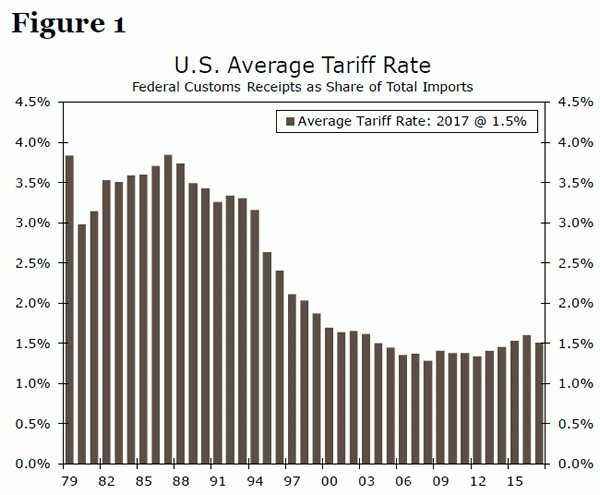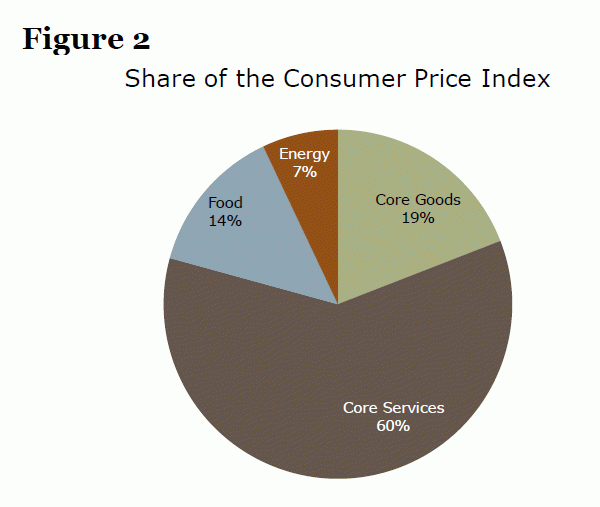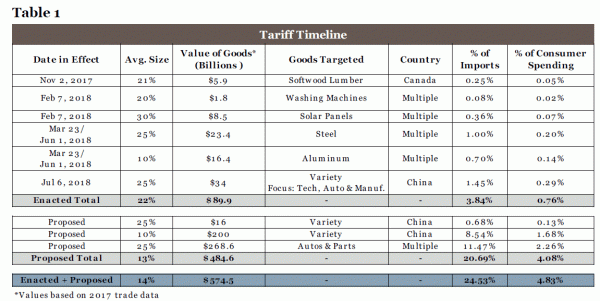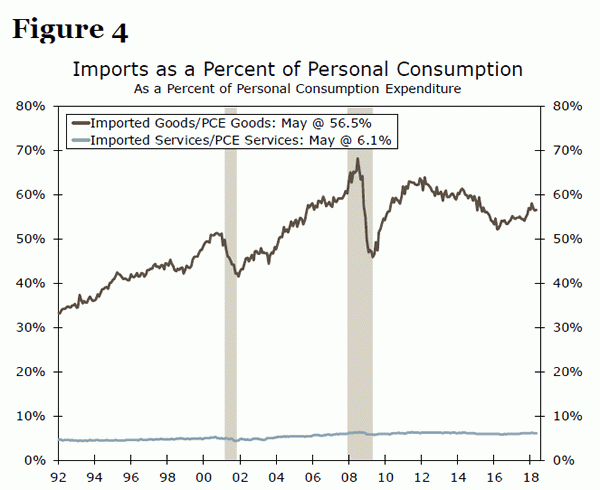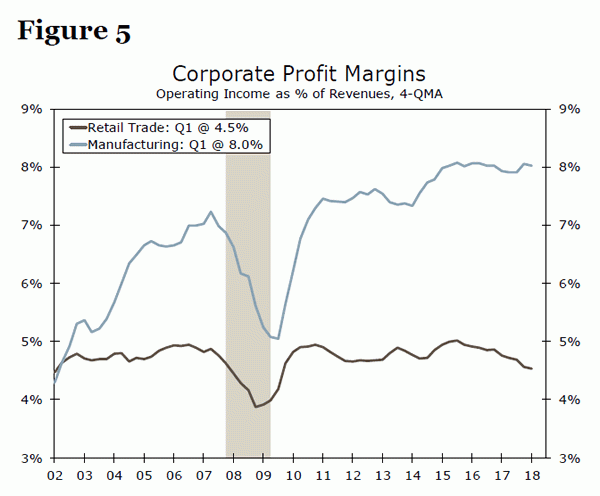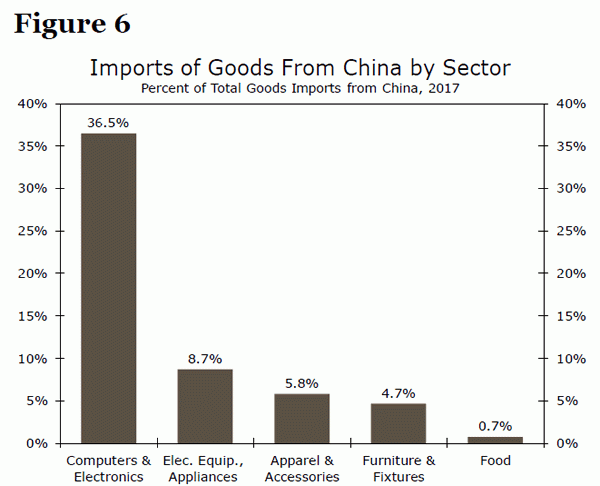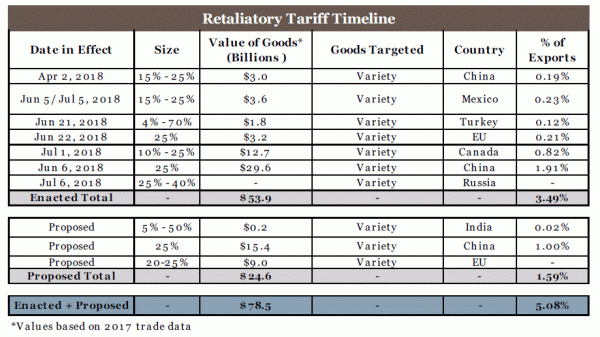Executive Summary
Trade tensions have been escalating since the spring when President Trump announced tariffs on steel and aluminum imports. Tit-for-tat responses to the initial tariffs levied by the administration earlier this year are beginning to add up. Supply chain managers have been left scrambling to find new sources of materials or face higher costs.
As shown in Figure 1, effective tariffs on U.S. imports have fallen substantially since the mid-1980s. While there is still tremendous uncertainty surrounding the size, targets and duration of tariffs under the current administration’s trade policy, it is clear that rates are at least no longer declining. We estimate that the measures already imposed would increase CPI inflation by a scant 0.1 percentage point. If all the additional tariffs being proposed were to go into effect, however, inflation would rise about 0.5 percentage points.
Keeping the effect on consumer price inflation thus far fairly modest, and limiting the impact if additional tariffs go into effect, are the composition and knock-on effects. The tariffs that have already gone into effect have focused on intermediate goods, meaning they equate to only a portion of the production cost. In addition, tariffs have been aimed at goods rather than services, and goods account for only about one-third of consumer spending (Figure 2). Consumers are also likely to adjust by buying goods from producers not covered by tariffs and/or reducing consumption of goods targeted. Second-order effects, such as retaliatory measures, a stronger dollar and weaker real growth also stand to mitigate the initial inflationary impulse of U.S. tariffs.
Overall, effects of tariffs that have already been enacted should be small enough to where the Fed does not need to alter its current course of policy on the basis of inflation. The additional proposed measures, however, stand to push inflation noticeably higher and weigh more meaningfully on real consumer spending.
Sizing Things Up: Tariffs Relative to U.S. Imports
Trade policy has been dominating the Trump administration’s economic agenda since the start of the year. The escalating trade rift looms over the U.S. economy. As more goods have fallen within the scope of tariffs, or are at risk to do so soon, concerns over the effect on output, jobs and prices have intensified. Since the immediate aim of tariffs are to raise the effective price of imports, it is worth assessing how recent changes to trade policy are likely to affect consumer price inflation.
As outlined in Table 1, there have already been a number of instances since late last year in which the United States has raised tariffs. Thus far, the tariffs that have gone into effect have been applied across a fairly small share of imports. In total, the administration’s major tariff changes apply to $90 billion of goods. In an economy that imported $2.3 trillion of goods in 2017, that represents 3.9 percent of total imports. With an average rate of 22 percent,1 that equates to 0.9 percent more spending on imports, all else equal.
The value of subsequent targets are materially higher. After China announced it would retaliate against the initial tariffs imposed by the United States, President Trump suggested that another $200 billion in tariffs on Chinese goods could follow. The $200 billion in tariffs are now under assessment, bringing them one step closer to becoming a reality. At the same time, tariffs on vehicles have been floated. Details are still sparse regarding rates and whether some countries would be excluded, but we assume all automobile and parts imports would be exposed to an additional 25 percent tariff. This provides an upper-end estimate to the effect on inflation. If all the currently-proposed targets came to pass, spending on imports would rise by a total of 3.5 percent.
How Much Will Consumer Price Inflation Rise?
How much can we expect consumer prices to rise as a result? That depends on a myriad of factors, which we discuss in more detail in the next section. However, looking at the size of tariffs in relation to imports and the relationship between import prices and consumer price inflation offers a guideline.
To determine how the jump in import prices would feed through to what consumers ultimately pay, we estimated a simple regression model. While the import price index excludes duties and other taxes such as tariffs, it still sheds light on the extent to which consumer prices move as import prices change. Although imports are not the only products being bought by U.S. consumers, their prices are highly correlated with domestically produced goods (Figure 3). Therefore, the change in import prices should also closely capture the tariff-related price changes to U.S. made products.
Prices on consumer goods are most exposed to tariffs given that the United States imports relatively few services (Figure 4). Holding other conditions like slack in the economy, inflation expectations and the dollar constant, the tariffs that have gone into effect would bump up CPI goods inflation, currently running at 2.9 percent, by 0.3 percentage points.2 If the additional tariffs proposed also came to fruition, inflation for consumer goods would be about 1.2 percentage points higher.
Spending on food, energy and other goods account for only about one-third of consumer outlays, however. As shown in Table 1, the value of goods exposed to tariffs equate to a much smaller share of total consumer spending than imports for this reason. Therefore, the effect on the overall CPI is noticeably smaller than it is if solely looking at consumer goods. Tariffs already imposed would add only about one-tenth of a percentage point to the overall rate of consumer price inflation. Taking into account the additional tariffs being floated, the change in headline CPI inflation would rise to 0.5 percentage point, again keeping other factors constant.
That’s It? Why So Small?
With consumer price inflation currently running around 2 percent, a 0.1 percentage point rise stemming from tariffs is not a game changer, in our view, to the inflation outlook. The additional tariffs being proposed present noticeably more risk to consumer spending power and the Fed’s goal of price stability. Yet, that is likely to be an upper bound, since auto tariffs may end up being more targeted and/or at a lower rate, while the composition, timing and generation of offsetting factors limit the effect on inflation.
Mitigating the effect on consumer prices is that tariffs have been targeted at intermediate goods, at least thus far. By and large, the tariffs that have gone into effect have been on goods used in manufacturing and for commercial purposes. That has thrown supply chains into disarray and forced many manufacturers to pay up for inputs. Yet, final selling prices reflect a multitude of inputs, such as labor, transportation and marketing. In addition, businesses may accept lower margins rather than adjust selling prices in a one-to-one fashion with changes in input costs. Businesses appear to have room to absorb higher costs, especially with the recent cut to corporate tax rates. Profit margins across the economy remain historically high, especially in the manufacturing sector (Figure 5).
The potential application of tariffs to another $200 billion worth of imports from China makes it impossible to avoid tariffs on imported consumer goods. Of the $505 billion in imports from China last year, more than half were finished electronics or other consumer goods (Figure 6). Tariffs on all auto-related imports would also hit consumer price inflation fairly hard. Relative to historical rates, retailers have less scope to cut margins.
Timing also matters for the extent to which inflation will be affected. Higher tariffs raise the price level, leading to a one-time boost to inflation. In order for inflation to maintain a higher rate, however, subsequent increases would need to follow, unless inflation expectations were to become unmoored. Therefore, not only is the direct effect on inflation likely to be transitory, but the staggered roll out of tariffs should limit how much tariffs raise the inflation rate for any single period.
Knock-On Effects of Tariffs
Perhaps more important for the inflation outlook are the likely knock-on effects from the imposition of tariffs. How tariffs feed through the economy, affecting supply and demand, determines their ultimate effect on prices. Here, we have to consider not just tariffs imposed by the United States, but also retaliatory tariffs imposed by trading partners.
As we have already discussed, higher import prices provide a modest initial boost to overall consumer prices. Over time, however, the boost to prices may ease as producers not covered by tariffs (domestic factories or those in tariff-exempt countries) increase supply and capture more market share. The time horizon for supply chains to re-adjust depends on where existing production capacity is located, how easy it is for firms to move production/change suppliers and how long tariffs are likely to be in place.
In cases where tariffs have been applied across nearly all trading partners (solar panels, aluminum and steel to date),3 the only way to avoid tariffs is to source domestically. We expect U.S. manufacturers to increase steel production in response to tariffs, although this has yet to show up in industrial production data. However, steel production costs in the United States tend to be higher than abroad and U.S. firms are facing less price competition as a result of tariffs, which should keep prices elevated even when the direct cost of tariffs is avoided.
For goods covered by worldwide tariffs where American producers still lack a comparative advantage, even with tariffs, consumers will have to swallow higher import costs or reduce consumption. This is likely to be the case for solar panels, for example. In 2017, the United States and Canada together accounted for only 3.7 percent of worldwide solar module production, with China and Taiwan holding a clear lead at 70 percent.4 Imports make up about 80 percent of American consumption of solar modules.5 Given that solar module production is capital-intensive– building capacity is an expensive and long process—and tariffs are set to end after four years, domestic production is unlikely to replace a substantial share of solar imports. Rather, solar installation is likely to become more expensive,6 and demand for new solar power is likely to decline. The effect on consumer prices, through utility prices, will depend on the extent of substitution to other energy sources.
Where the United States has only imposed tariffs on imports from a particular country, such as China, we can expect trade diversion to occur, which would limit the effect of tariffs on prices. For instance, after the United States imposed stiff duties on solar cells manufactured in China and Taiwan in 2012 and 2015, solar cell imports from South Korea rose to a record high. For goods targeted in the first round of U.S. tariffs on Chinese imports, China supplies 7 percent of worldwide imports to the United States, although this rises to 13 percent for goods in the second round and 92 percent for some items. Given China’s relatively small share of imports for these items, U.S. producers will likely be able to adjust supply chains to avoid the full impact of tariffs in many cases.
So far, we have only considered the supply and demand effect of tariffs imposed by the United States. Foreign countries, however, have retaliated on more than $50 billion of U.S. exports (Table 2). Retaliatory tariffs put downward pressure on U.S. consumer prices indirectly, if tariffs reduce the competitiveness of U.S. exports and, therefore, boost domestic supply as fewer goods are sold abroad. This risk is particularly acute for goods that the United States exports in large volume, such as soybeans and pork. Fresh foods, such as pork, must be consumed immediately, meaning that U.S. producers have little ability to deal with excess supply as a result of tariffs. Hog futures, for example, fell 1.5 percent after Mexico announced plans to levy tariffs of 20 percent against U.S. pork on June 5.
Putting specific tariffs aside, a trade war also has implications for consumer prices because of its effect on the U.S. dollar and growth. In times of risk-off market sentiment, the U.S. dollar tends to strengthen; uncertainty around the implications of trade tensions for global growth have been one factor supporting the U.S. dollar in recent months. On the margin, a stronger dollar puts downward pressure on import prices, counteracting some of the boost provided by U.S. tariffs.
If a trade war causes global growth to slow—the Bank of Canada recently called trade protectionism the “most important threat to global prospects”7—then global demand growth is also likely to slow. As FOMC members have highlighted, companies may put capital expenditure plans on hold in the face of trade uncertainties. Consumers, faced with higher prices, may pull back spending. These reactions would mean less pressure on capacity and, therefore, less upward pressure on prices.
Conclusion: Tariffs Not Enough to Change Fed Stance on Inflation
There remains tremendous uncertainty surrounding the ultimate effect of the Trump administration’s stance on trade policy. The reduction in trade barriers over the past few decades has been one factor in keeping inflation historically low in recent decades. The upending of this system stands to throw the downward pressure on inflation into reverse. So far, the effect on consumer price inflation from the enacted tariffs likely will be small, but the additional tariffs being discussed would raise consumer price inflation more meaningfully.
Certain industries, such as manufacturing, are feeling the effect of tariffs more acutely given the highly specialized and global reach of supply chains. When setting monetary policy, however, the FOMC’s goal of price stability is benchmarked against consumer price inflation, since higher input costs do not always result in higher final prices.
Just as the FOMC was reluctant to alter its projections on the economy based on potential changes to fiscal policy surrounding last year’s tax bill, the Fed is unlikely to alter monetary policy on potential changes to tariffs. Given the small and temporary effect of the tariffs raised thus far, we do not expect to see the Fed meaningfully alter its current stance on inflation. Inflation has been running below the Fed’s target for the better part of this expansion, and the FOMC has stressed its willingness to accept a modest overshoot, especially if temporary, for a time given the symmetric nature of its inflation target. However, inflation could end up rising more meaningfully if trade barriers continue to rise. Looking through the potential temporary impact to tariffs is also likely to be made difficult since they are coming at a time in which underlying inflationary pressures are already picking up.




